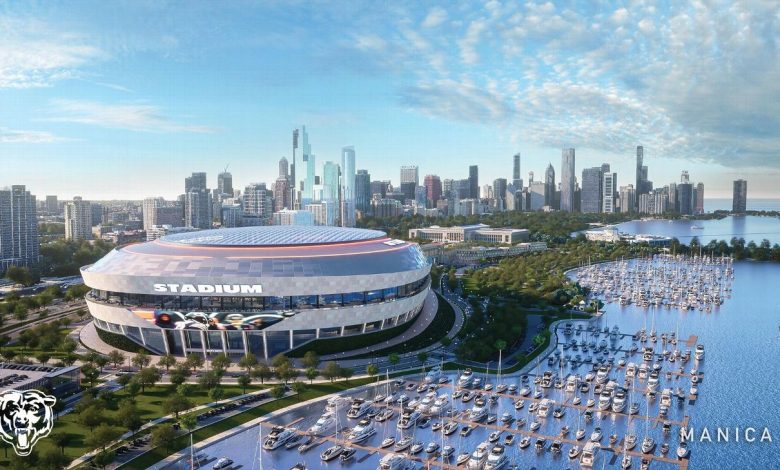A New Chicago Bears Stadium Proposal?

A New Chicago Bears Stadium Proposal: The Future of Football in the Windy City
For decades, Soldier Field has been the iconic home of the Chicago Bears, standing as one of the NFL’s oldest and most storied stadiums. But with the franchise’s long-term future at the venue growing more uncertain, a new proposal has emerged: the idea of a state-of-the-art stadium, potentially in a different location, to house one of the NFL’s most iconic teams. This proposal has sparked conversation, controversy, and excitement as fans and city officials alike weigh the potential impact a new Bears stadium could have on the team, the city, and the community.
As the NFL continues to evolve, so too does the stadium experience. The demands of modern-day fans, the increasing cost of maintaining older stadiums, and the opportunities presented by newer, more technologically advanced venues have all played a role in the Bears’ pursuit of a new home. But while many fans associate Soldier Field with the rich history and tradition of the Bears, the reality is that the stadium is increasingly seen as a relic of the past. Is it time for the Bears to say goodbye to Soldier Field? The question of whether a new stadium would better serve the franchise is one that has been raised time and again.
A new stadium for the Bears isn’t just about providing a fresh coat of paint on an old venue—it’s about reimagining the fan experience, increasing revenue streams, and positioning the franchise for long-term success. It’s about meeting the needs of today’s fans and building a venue that can stand the test of time. With all of these factors in play, the question of a new stadium has become a central focus of the Bears’ future. Here, we’ll explore the details of this proposal, its implications for the city of Chicago, and what a new stadium could mean for the Bears, their fans, and the community.
The Current State of Soldier Field
Before diving into the proposal itself, it’s important to understand the history and current state of Soldier Field. Built in 1924, Soldier Field is one of the oldest stadiums in the NFL. It’s located in Grant Park, a central area of downtown Chicago, providing fans with a stunning view of the city’s skyline. The stadium’s history is steeped in tradition, and it has seen countless legendary moments, from the dominance of the 1985 Chicago Bears to numerous iconic games throughout the decades. But while Soldier Field’s historical significance cannot be denied, the reality is that the stadium has aged and is no longer in line with the modern demands of NFL teams and fans.
The most significant renovation to Soldier Field occurred in 2003 when the stadium underwent a controversial $600 million overhaul. The renovation modernized certain parts of the stadium, such as the addition of new seating, suites, and a modernized press box. However, the renovation also left much of the old structure intact, which resulted in a clash of architectural styles between the historic exterior and the modernized interior. The changes left some fans and city officials dissatisfied, as the stadium’s overall feel remained outdated compared to newer NFL venues.
Moreover, Soldier Field’s location poses challenges. Its downtown setting, while scenic, creates logistical hurdles for fans, particularly when it comes to parking. The stadium is located in a tight urban area, and the lack of parking options has led to traffic congestion, particularly on game days. Fans and teams alike have expressed frustration with the stadium’s accessibility, and the city’s lack of infrastructure around the stadium has further complicated the experience.
Another issue with Soldier Field is its capacity and the lack of premium seating options. Many modern NFL stadiums are designed with luxurious suites, club seating, and other high-end amenities that generate significant revenue for the teams. Soldier Field, however, has been unable to compete with these newer stadiums in terms of maximizing revenue from these sources. This has made it increasingly difficult for the Bears to keep pace with the financial demands of running an NFL franchise in a competitive landscape.
The Need for a New Stadium
The call for a new stadium is, in large part, a response to these challenges. A modern stadium would not only address the logistical issues that fans experience when attending games, but it would also provide the Bears with the opportunity to generate more revenue through premium seating, suites, and modern amenities. Additionally, a new stadium could feature enhanced fan experiences, such as improved concessions, updated technology, and better overall infrastructure.
But the need for a new stadium goes beyond just logistics and revenue. As the NFL continues to grow in popularity, teams are increasingly expected to offer more than just a game on Sundays. Modern stadiums are entertainment hubs that provide a complete fan experience, offering everything from high-end dining and shopping options to immersive digital experiences. A new stadium would allow the Bears to capitalize on these trends, ensuring that the team remains competitive both on and off the field for years to come.
Furthermore, the Bears are not alone in seeking a new stadium. Across the NFL, teams are investing in new, state-of-the-art venues in order to stay competitive in the rapidly changing sports landscape. Teams like the Los Angeles Rams, Las Vegas Raiders, and Minnesota Vikings have all opened new stadiums in recent years, complete with cutting-edge technology, premium seating, and additional revenue-generating features. As one of the most valuable franchises in the NFL, the Bears are under increasing pressure to keep up with these trends.
The Proposal: A New Chicago Bears Stadium
The proposal for a new Bears stadium has been under discussion for several years. The team’s ownership, led by the McCaskey family, has expressed a desire to build a new home for the team that would allow for a better fan experience, generate more revenue, and provide the franchise with a modern facility that can meet the demands of the 21st century.
One of the key aspects of the proposal is the location. While Soldier Field is situated in the heart of downtown Chicago, the Bears have been looking at other areas in the Chicago metropolitan area for a new stadium. One potential location that has been discussed is Arlington Heights, a suburb located about 25 miles northwest of downtown Chicago. The site is home to the Arlington International Racecourse, which could be redeveloped into a massive sports and entertainment complex. This location has several advantages, including more space for parking, better traffic flow, and the potential for a much larger stadium.
The Arlington Heights site would allow the Bears to build a stadium with a much larger capacity than Soldier Field, potentially accommodating upwards of 60,000 fans, compared to Soldier Field’s current capacity of around 61,500. In addition, a stadium in Arlington Heights would provide the opportunity for the Bears to create a year-round entertainment complex, including retail shops, hotels, restaurants, and entertainment venues. This could turn the stadium into a major economic hub, benefiting the team and the local community.
While Arlington Heights is one of the primary options being considered, other potential sites in the Chicago area have also been explored, including locations near O’Hare International Airport and in the western suburbs. The challenge, however, lies in finding a location that provides both accessibility for fans and the potential for future growth.
The Financials: Who Will Pay for the New Stadium?
One of the most significant hurdles in the proposal for a new Bears stadium is how to finance it. Building a new stadium is an expensive proposition, with costs often reaching billions of dollars. In the past, teams have funded new stadiums through a combination of private investment, public funding, and revenue from the stadium’s operations.
In the case of the Bears, the team has expressed a willingness to contribute a significant portion of the funding, but there are ongoing discussions about whether public money should be used to help cover the costs. This has been a point of contention, as many city officials and taxpayers are wary of using public funds for such an expensive project. However, proponents of the new stadium argue that it would generate long-term economic benefits for the city, creating jobs, increasing tourism, and boosting local businesses. Additionally, a new stadium would increase the Bears’ ability to host major events like the Super Bowl, college football playoff games, and concerts, further driving revenue and benefiting the city.
The Impact on Chicago and the Bears
If the proposal for a new Bears stadium moves forward, the impact on both the franchise and the city could be profound. For the Bears, a new stadium represents a significant opportunity to increase revenue, improve the fan experience, and position the team for long-term success. The financial resources generated from a new stadium could help the Bears remain competitive in a rapidly evolving NFL landscape, allowing them to invest in player development, coaching, and technology.
For the city of Chicago, the new stadium could bring significant economic benefits. It could create thousands of new jobs, increase tourism, and revitalize neighborhoods around the stadium. A state-of-the-art stadium would attract major events and could help establish Chicago as a premier sports and entertainment destination.
However, it’s also clear that a new stadium proposal is not without its challenges. The Bears will need to navigate complex negotiations with the city, local governments, and potential investors. Additionally, some fans may be nostalgic about Soldier Field and reluctant to support a move away from the stadium that has been their home for so many years.









